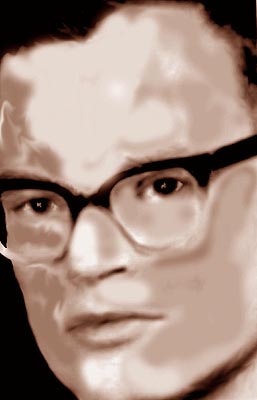www.johngill.net
Bouldering Companions
 Pete Cleveland
: Here is a portrait
of Pete done by Pat Ament. And this photo of
Pete
on Steak Sauce
at Devils Lake was apparently taken
in the 1970s.
Pete Cleveland
: Here is a portrait
of Pete done by Pat Ament. And this photo of
Pete
on Steak Sauce
at Devils Lake was apparently taken
in the 1970s.
I first met Pete in the Tetons in the
1960s. We bouldered there, and climbed
and bouldered together in the Needles
of the Black Hills. Pete is probably
the most undersung of the great American
rock climbers. This superlative climber
was ahead of his generation, and I found him
to be a top bouldering competitor, as well.
In the Tetons in 1966, after Bob Kamps and Yvon
Chouinard had retreated from the north face of the
Crooked Thumb (Yvon took
a horrendous and spectacular swan dive of a fall
when his pin pulled out - this dampened their enthusiasm
for such a rotten and dangerous piece of Teton rock),
Pete's the guy who went up there and did it (18
pitches, 3 days). On the Jenny Lake boulders, he may
have been the first to do the static variation of Gill's
Route on Red Cross Rock.
In the Needles,
he and I worked on the FA of the
Outlet Boulder
Overhang together. Pete
had managed to squirm his way
up a tight dihedral after he and I
had tried this several times, and he
had almost gotten the problem when he came
off, fell through my spot, and ended in a cloud
of dust on the gound, flat on his back. As he
lay there panting, and with dust curling up around
him, he said " I can DO this!". Unable to squeeze
my larger frame into the folded rock, I had
fallen behind in the contest. But then, fortunately,
I discovered a dynamic method of passing
the initial part and reached the critical handhold
unfatigued. We both got the problem,
but we had a helluva time in the process!
On another occasion, we went up to make the
FA of a thin spire I named El Mokanna
, in the Picket Fence Area.
Climbing up the north side, the
top crux pitch was essentially a large
slightly overhanging boulder problem.
I got a piton in at foot level in the corner
of a small shelf we were standing
on below the crux, then climbed up the thin
nubbined bulge for a few feet, reaching
an apparent impasse. After a moment's non-deliberation
I trusted my Needles' instinct and made
a blind dynamic move up and around a corner.
Fortuitously, there was a hold there that could
not be seen from below, and I was able to instinctively
lock onto it and then climb to the top(5.9-5.10).
Pete said "You shouldn't have to do that, it looks too risky".
When he reached the same spot he hesitated, then did
what I had done. If it weren't for my desire to impress
my extremely bold companion, I would have studied the
rock more intensely, and found a less dramatic sequence.
(In 1969 Mark and Beverly Powell found a route on
the south side that went at 5.6).
I recall watching
Pete as he did one of the longer
and more barren Needles. I believe
he scrambled up a tree rising next to
the long, downhill side of the nubbly
spire, and fastened a sling in its upper
branches for protection on the otherwise
unprotectable bottom section of the climb,
although I could be confusing this with
either another climb or the first reconnaissance
of this one. (Using a tree sling was standard,
reasonable, and acceptable practice at the
time - for instance, the regular route up the Incisor
, done by Bob Kamps and me, involved a tree sling).
I do recall with more clarity the great calmness
and deliberation Pete exhibited as he climbed
the final thin and exposed 30 or 40 feet to the top
- as risky a lead as I've ever seen. He had the finest control
of his nerves (and climbing demeaner) of any
climber I've ever known. At that time I would not
have tried doing what he did. Henry Barber, who arrived
on the climbing scene several years later, had the
same kind of nerveless and bold climbing style.
At Devil's Lake,
Pete floated past my hardest 1959
routes and put up a number of truly
new-age climbs, stunning in
their difficulty. His top-rope of
Phlogiston set a new standard
for that time (it was given a bouldering
rating of B2 for a while).
Pete didn't have much interest
in auxiliary training for climbing.
He avoided my gymnastic approach,
and I can remember a comment he made to me:
"You need to remain fairly thin and avoid
gymnastic exercises that bulk you up. The fingers
are the weakest link between climber and rock,
and hard climbing is the best exercise for them."
He also speculated that the fingers would
be the first point of weakening and failure as one
grew old, and I agreed with him. As it turns out,
we were wrong about that.
I admired Pete
even more because of the tremendous
intellectual content of his life: he
earned a PhD in Chemistry from Iowa
(his thesis yielded information on the
deterioration of nylon ropes and slings),
and when he found jobs were scarce and he
didn't enjoy teaching, he earned an MD.
Later, he worked in the state prison system
in Wisconsin – avoiding the big bucks of
private practice and going to a place where
he was needed the most. Kudos to this multi-talented
climber and professional – unquestionably,
one of the top rock aces of his era! (2003)